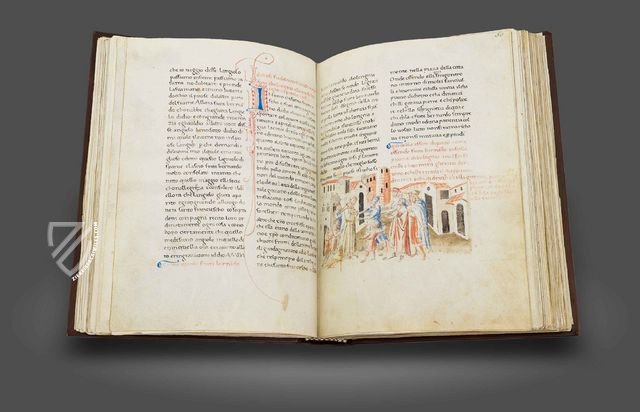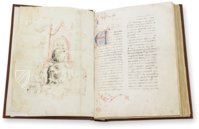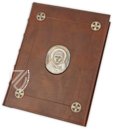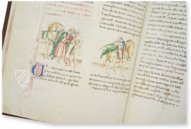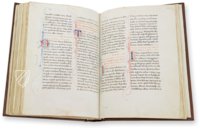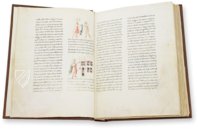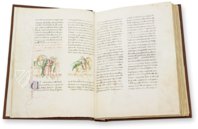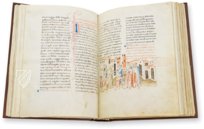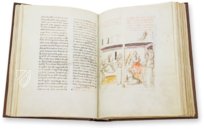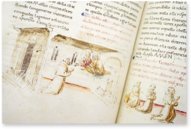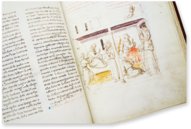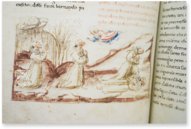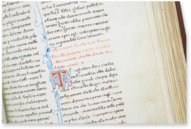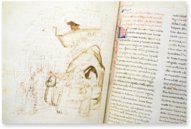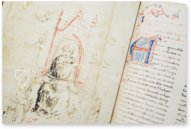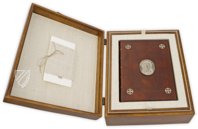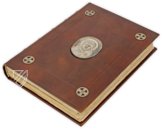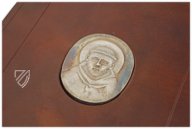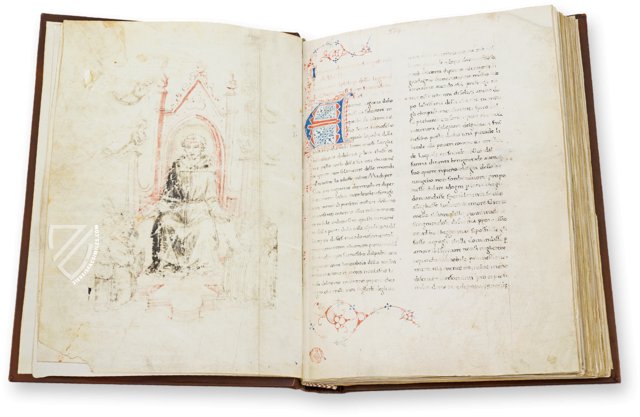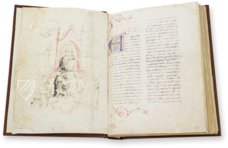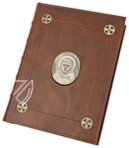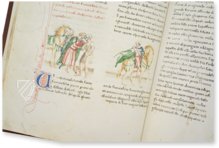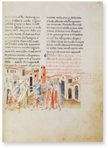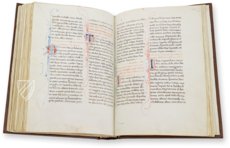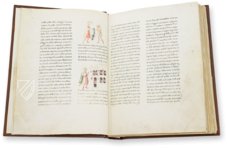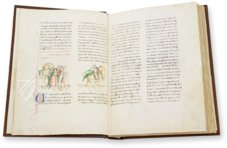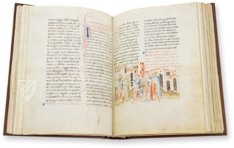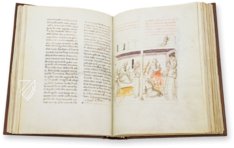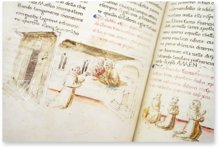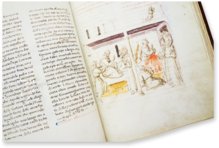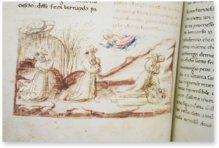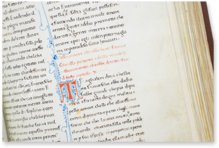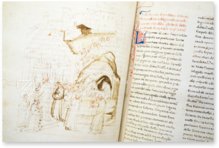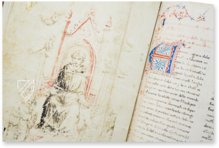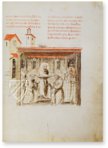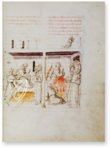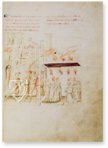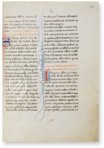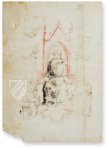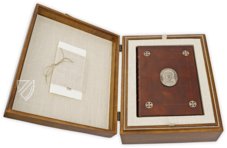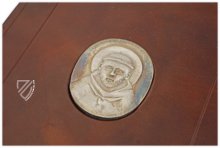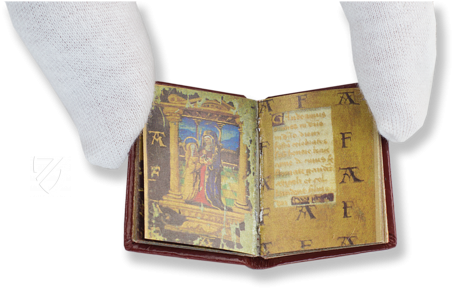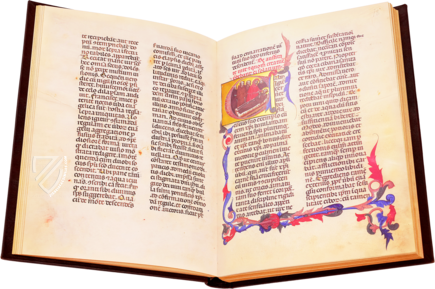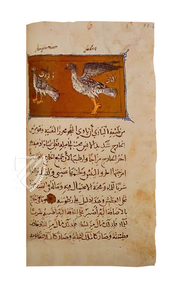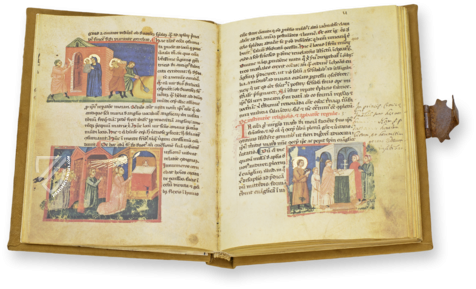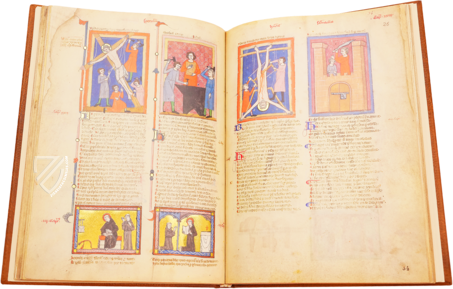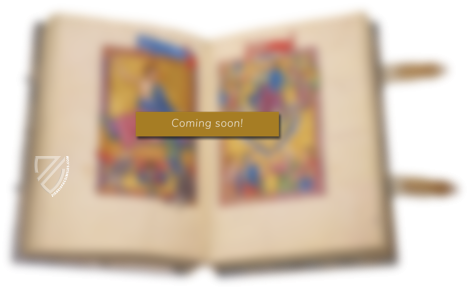Life and Works of Francis of Assisi
(3,000€ - 7,000€)
The Legend of the Life and Works of Francis of Assisi (1181–1226) recounts various legendary stories from the life of the founder of the Franciscan order, who is said to have found the true faith during a pilgrimage to Rome. In keeping with the monastic ideal of modesty, this copy of the hagiographic text corpus, created in Florence in 1427, has been illuminated with simple yet immensely expressive washed pen-and-ink drawings. The 30 miniatures highlight central events from Francis' eventful life and bring the saint's life home to the beholder in an impressive way. The restrained color palette probably also helped medieval readers meditate on the text, which is written in a proper humanist minuscule and structured by elaborate fleuronnée initials. Thus, the Quattrocento manuscript represents a wonderful testimony to the veneration of St. Francis.
Life and Works of Francis of Assisi
Francis of Assisi was the founder of the Order of the Friars Minor, which is also known as the Franciscan Order. He is honored as a saint in the Catholic Church. His teachings about living in poverty and humility were taken as an example by many people. Saint Francis’s important acts and experiences are described in the codex about his life and work. The work is adorned with 30 illustrations of charming simplicity.
Who was Francis of Assisi?
Numerous legends exist about the life of Saint Francis of Assisi, the veracity of which is not always verifiable. According to these legends, Francis lead a dissolute life in his youth, with his father’s money he treated his peers at feasts and often was the focus of these celebrations. In November of 1202, Francis is supposed to have gone off with soldiers from his hometown of Assisi to war against the neighboring city of Perugia, where Assisi was defeated. Francis and his fellow soldiers were taken into captivity as prisoners of war in Perugia. His came to question his reckless life through the experience of the war and was sick and shaken to the core when he was released. Francis increasingly withdrew from his circle of friends in this period and sought solitude.
God’s Call
He undertook a pilgrimage to Rome in 1205 and 1206, on which he, according to legend, traded clothes with a beggar in order to “try out” life in complete poverty. He began to live as a hermit. He went begging house to house for food. His referred to his voluntary poverty – in reference to chivalric ideas and courtly love songs – as his “mistress”. Francis lived according to the word of the Gospels, not only in a metaphorical sense. He understood the biblical texts as a call to thus live and act as did the twelve young men sent out by Jesus, the Apostles, namely to live in poverty and proclaim the Gospels. Based on the Gospels, Francis clothed himself from then on in a simple habit, which is held with a rope, strictly rejected possessions and even contact with money, and went barefoot when possible. His lifestyle came across scorn and mockery, but on the other hand, acted as a stimulus for numerous others of like mind. From the growing number of his followers arose the Order of the Friars Minor.
Modest Book Decoration
In keeping with the life of St. Francis of Assisi, the codex was furnished to tell the stories of his deeds and virtues. The work contains 30 miniatures, which are painted in light water colors and are contoured with ink. The pictures are modest and yet of high artistic quality. With few materials, the stories and experiences that are portrayed in the text are vividly depicted visually. Not all images were colored. In some places the text is adorned with colorful initials. The manuscript invites consideration and meditation about life in the Middle Ages, secluded from the influences of our modern time.
Codicology
- Alternative Titles
- San Francesco d'Assisi, la vita e le opere
I Fioretti di
San Francesco
Il Suo Testamento
Leben und Wirken des Heiligen Franz von Assisi
Life and Writings of Francis of Assisi - Size / Format
- 372 pages / 29.0 × 21.7 cm
- Origin
- Italy
- Date
- 1427
- Epochs
- Style
- Genre
- Language
- Script
- Humanistic
- Illustrations
- 30 miniatures in ink and watercolors
- Content
- Life of St. Francis, his testament, the Fioretti; reflections on the stigmata and treatise on the miracles of St. Francis by Tommaso da Celano and the biographies of the friars Ginepro, Leone and Egidio
- Previous Owners
- Convent of Sant'Onofrio
Biblioteca Gaddi
Biblioteca Magliabecchiana
Life and Works of Francis of Assisi
The Blessing of Friar Bernardo
This scene occurs in an interior space with mullioned windows and the surrounding cityscape is shown with a bell tower and lightly sketched trees: Francis, feeling the approach of his own death, wanted to bless Friar Bernardo who in turn asked Friar Elias to position himself on the Saint’s right side in his place. Despite his advanced blindness, Francis senses this and crosses his arm in order to place his right hand on Bernardo’s head and his left on that of Elias for the blessing.
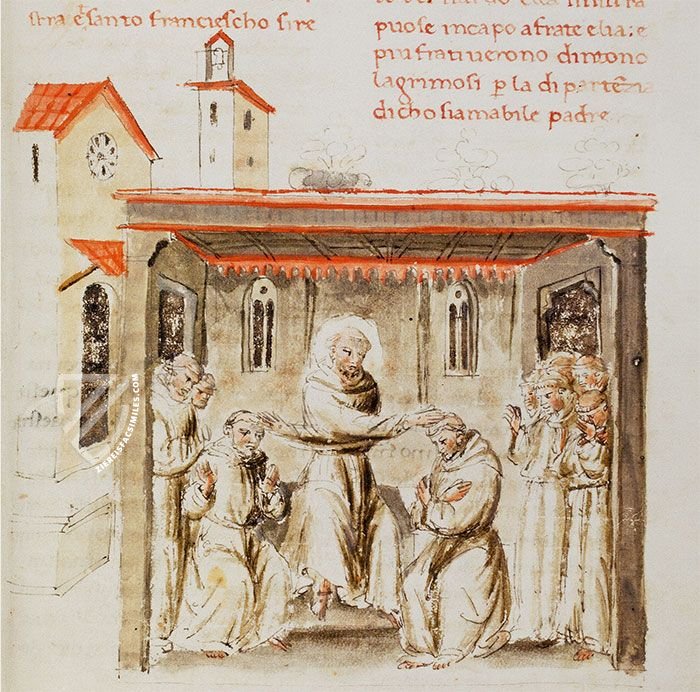
Life and Works of Francis of Assisi
The Burning Faith of Francis and Clare
In a continuation from the previous story, Francis and Clare are so fervently engaged in prayer and enraptured by God that it appears as though the Porziuncola, a church in Assisi, is on fire and the residents of Assisi rush to put it out. Francis, Clare, and their companions are all depicted kneeling in prayer inside the church as flames rise above their heads, out of the windows, and on the roof.
The men of Assis are depicted pouring out of the gate of a walled city to the left and one even carries a poleaxe, presumably for breaking down a door. However, as soon as they enter through the doors of the Porziuncola, they are amazed to find that it is in fact a miraculous, divine fire that they have witnessed engulfing the sacred building.
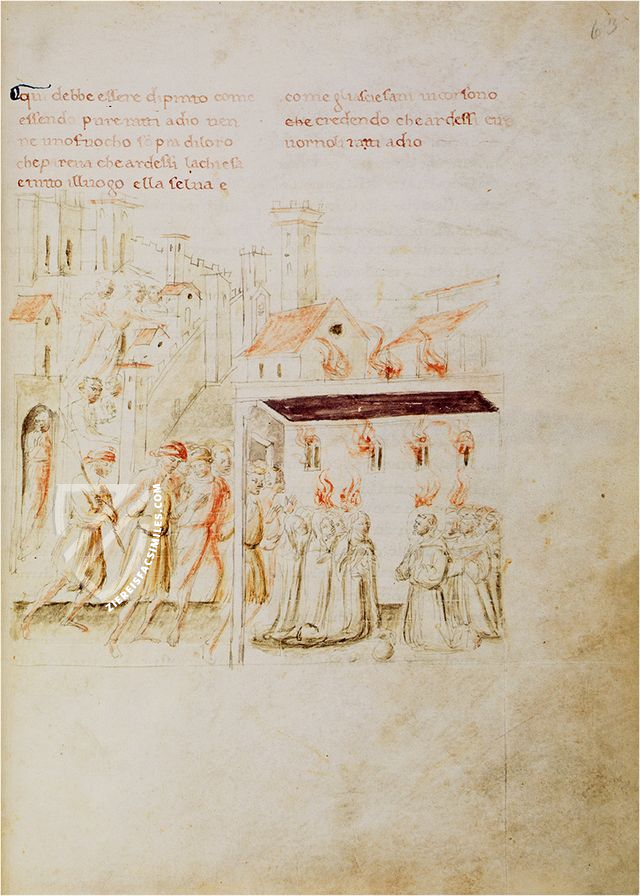
- Treatises / Secular Books
- Apocalypses / Beatus
- Astronomy / Astrology
- Bestiaries
- Bibles / Gospels
- Chronicles / History / Law
- Geography / Maps
- Saints' Lives
- Islam / Oriental
- Judaism / Hebrew
- Single Leaf Collections
- Leonardo da Vinci
- Literature / Poetry
- Liturgical Manuscripts
- Medicine / Botany / Alchemy
- Music
- Mythology / Prophecies
- Psalters
- Other Religious Books
- Games / Hunting
- Private Devotion Books
- Other Genres
- Afghanistan
- Armenia
- Austria
- Belgium
- Belize
- Bosnia and Herzegovina
- China
- Colombia
- Costa Rica
- Croatia
- Cyprus
- Czech Republic
- Denmark
- Egypt
- El Salvador
- Ethiopia
- France
- Germany
- Greece
- Guatemala
- Honduras
- Hungary
- India
- Iran
- Iraq
- Israel
- Italy
- Japan
- Jordan
- Kazakhstan
- Kyrgyzstan
- Lebanon
- Liechtenstein
- Luxembourg
- Mexico
- Morocco
- Netherlands
- Palestine
- Panama
- Peru
- Poland
- Portugal
- Romania
- Russia
- Serbia
- Spain
- Sri Lanka
- Sweden
- Switzerland
- Syria
- Tajikistan
- Turkey
- Turkmenistan
- Ukraine
- United Kingdom
- United States
- Uzbekistan
- Vatican City
- A. Oosthoek, van Holkema & Warendorf
- Aboca Museum
- Ajuntament de Valencia
- Akademie Verlag
- Akademische Druck- u. Verlagsanstalt (ADEVA)
- Aldo Ausilio Editore - Bottega d’Erasmo
- Alecto Historical Editions
- Alkuin Verlag
- Almqvist & Wiksell
- Amilcare Pizzi
- Andreas & Andreas Verlagsbuchhandlung
- Archa 90
- Archiv Verlag
- Archivi Edizioni
- Arnold Verlag
- ARS
- Ars Magna
- ArtCodex
- AyN Ediciones
- Azimuth Editions
- Badenia Verlag
- Bärenreiter-Verlag
- Belser Verlag
- Belser Verlag / WK Wertkontor
- Benziger Verlag
- Bernardinum Wydawnictwo
- BiblioGemma
- Biblioteca Apostolica Vaticana (Vaticanstadt, Vaticanstadt)
- Bibliotheca Palatina Faksimile Verlag
- Bibliotheca Rara
- Boydell & Brewer
- Bramante Edizioni
- Bredius Genootschap
- Brepols Publishers
- British Library
- C. Weckesser
- Caixa Catalunya
- Canesi
- CAPSA, Ars Scriptoria
- Caratzas Brothers, Publishers
- Carus Verlag
- Casamassima Libri
- Centrum Cartographie Verlag GmbH
- Chavane Verlag
- Christian Brandstätter Verlag
- Circulo Cientifico
- Club Bibliófilo Versol
- Club du Livre
- CM Editores
- Collegium Graphicum
- Collezione Apocrifa Da Vinci
- Comissão Nacional para as Comemorações dos Descobrimentos Portugueses
- Coron Verlag
- Corvina
- CTHS
- D. S. Brewer
- Damon
- De Agostini/UTET
- De Nederlandsche Boekhandel
- De Schutter
- Deuschle & Stemmle
- Deutscher Verlag für Kunstwissenschaft
- DIAMM
- Droz
- E. Schreiber Graphische Kunstanstalten
- Ediciones Boreal
- Ediciones Grial
- Ediclube
- Edições Inapa
- Edilan
- Editalia
- Edition Deuschle
- Edition Georg Popp
- Edition Leipzig
- Edition Libri Illustri
- Editiones Reales Sitios S. L.
- Éditions de l'Oiseau Lyre
- Editions Medicina Rara
- Editorial Casariego
- Editorial Mintzoa
- Editrice Antenore
- Editrice Velar
- Edizioni Edison
- Egeria, S.L.
- Eikon Editores
- Electa
- Emery Walker Limited
- Enciclopèdia Catalana
- Eos-Verlag
- Ephesus Publishing
- Ernst Battenberg
- Eugrammia Press
- Extraordinary Editions
- Fackelverlag
- Facsimila Art & Edition
- Facsimile Editions Ltd.
- Facsimilia Art & Edition Ebert KG
- Faksimile Verlag
- Feuermann Verlag
- Folger Shakespeare Library
- Franco Cosimo Panini Editore
- Friedrich Wittig Verlag
- Fundación Hullera Vasco-Leonesa
- G. Braziller
- Gabriele Mazzotta Editore
- Gebr. Mann Verlag
- Gesellschaft für graphische Industrie
- Getty Research Institute
- Giovanni Domenico de Rossi
- Giunti Editore
- Graffiti
- Grafica European Center of Fine Arts
- Guido Pressler
- Guillermo Blazquez
- Gustav Kiepenheuer
- H. N. Abrams
- Harrassowitz
- Harvard University Press
- Helikon
- Hendrickson Publishers
- Henning Oppermann
- Herder Verlag
- Hes & De Graaf Publishers
- Hoepli
- Holbein-Verlag
- Houghton Library
- Hugo Schmidt Verlag
- Idion Verlag
- Il Bulino, edizioni d'arte
- ILte
- Imago
- Insel Verlag
- Insel-Verlag Anton Kippenberger
- Instituto de Estudios Altoaragoneses
- Instituto Nacional de Antropología e Historia
- Introligatornia Budnik Jerzy
- Istituto dell'Enciclopedia Italiana - Treccani
- Istituto Ellenico di Studi Bizantini e Postbizantini
- Istituto Geografico De Agostini
- Istituto Poligrafico e Zecca dello Stato
- Italarte Art Establishments
- Jan Thorbecke Verlag
- Johnson Reprint Corporation
- Josef Stocker
- Josef Stocker-Schmid
- Jugoslavija
- Karl W. Hiersemann
- Kasper Straube
- Kaydeda Ediciones
- Kindler Verlag / Coron Verlag
- Kodansha International Ltd.
- Konrad Kölbl Verlag
- Kurt Wolff Verlag
- La Liberia dello Stato
- La Linea Editrice
- La Meta Editore
- Lambert Schneider
- Landeskreditbank Baden-Württemberg
- Leo S. Olschki
- Les Incunables
- Liber Artis
- Library of Congress
- Libreria Musicale Italiana
- Lichtdruck
- Lito Immagine Editore
- Lumen Artis
- Lund Humphries
- M. Moleiro Editor
- Maison des Sciences de l'homme et de la société de Poitiers
- Manuscriptum
- Martinus Nijhoff
- Maruzen-Yushodo Co. Ltd.
- MASA
- Massada Publishers
- McGraw-Hill
- Metropolitan Museum of Art
- Militos
- Millennium Liber
- Müller & Schindler
- Nahar - Stavit
- Nahar and Steimatzky
- National Library of Wales
- Neri Pozza
- Nova Charta
- Oceanum Verlag
- Odeon
- Orbis Mediaevalis
- Orbis Pictus
- Österreichische Staatsdruckerei
- Oxford University Press
- Pageant Books
- Parzellers Buchverlag
- Patrimonio Ediciones
- Pattloch Verlag
- PIAF
- Pieper Verlag
- Plon-Nourrit et cie
- Poligrafiche Bolis
- Presses Universitaires de Strasbourg
- Prestel Verlag
- Princeton University Press
- Prisma Verlag
- Priuli & Verlucca, editori
- Pro Sport Verlag
- Propyläen Verlag
- Pytheas Books
- Quaternio Verlag Luzern
- Reales Sitios
- Recht-Verlag
- Reichert Verlag
- Reichsdruckerei
- Reprint Verlag
- Riehn & Reusch
- Roberto Vattori Editore
- Rosenkilde and Bagger
- Roxburghe Club
- Salerno Editrice
- Saltellus Press
- Sandoz
- Sarajevo Svjetlost
- Schöck ArtPrint Kft.
- Schulsinger Brothers
- Scolar Press
- Scrinium
- Scripta Maneant
- Scriptorium
- Shazar
- Siloé, arte y bibliofilia
- SISMEL - Edizioni del Galluzzo
- Sociedad Mexicana de Antropología
- Société des Bibliophiles & Iconophiles de Belgique
- Soncin Publishing
- Sorli Ediciones
- Stainer and Bell
- Studer
- Styria Verlag
- Sumptibus Pragopress
- Szegedi Tudomànyegyetem
- Taberna Libraria
- Tarshish Books
- Taschen
- Tempus Libri
- Testimonio Compañía Editorial
- Thames and Hudson
- The Clear Vue Publishing Partnership Limited
- The Facsimile Codex
- The Folio Society
- The Marquess of Normanby
- The Richard III and Yorkist History Trust
- Tip.Le.Co
- TouchArt
- TREC Publishing House
- TRI Publishing Co.
- Trident Editore
- Tuliba Collection
- Typis Regiae Officinae Polygraphicae
- Union Verlag Berlin
- Universidad de Granada
- University of California Press
- University of Chicago Press
- Urs Graf
- Vallecchi
- Van Wijnen
- VCH, Acta Humaniora
- VDI Verlag
- VEB Deutscher Verlag für Musik
- Verlag Anton Pustet / Andreas Verlag
- Verlag Bibliophile Drucke Josef Stocker
- Verlag der Münchner Drucke
- Verlag für Regionalgeschichte
- Verlag Styria
- Vicent Garcia Editores
- W. Turnowski Ltd.
- W. Turnowsky
- Waanders Printers
- Wiener Mechitharisten-Congregation (Wien, Österreich)
- Wissenschaftliche Buchgesellschaft
- Wissenschaftliche Verlagsgesellschaft
- Wydawnictwo Dolnoslaskie
- Xuntanza Editorial
- Zakład Narodowy
- Zollikofer AG

